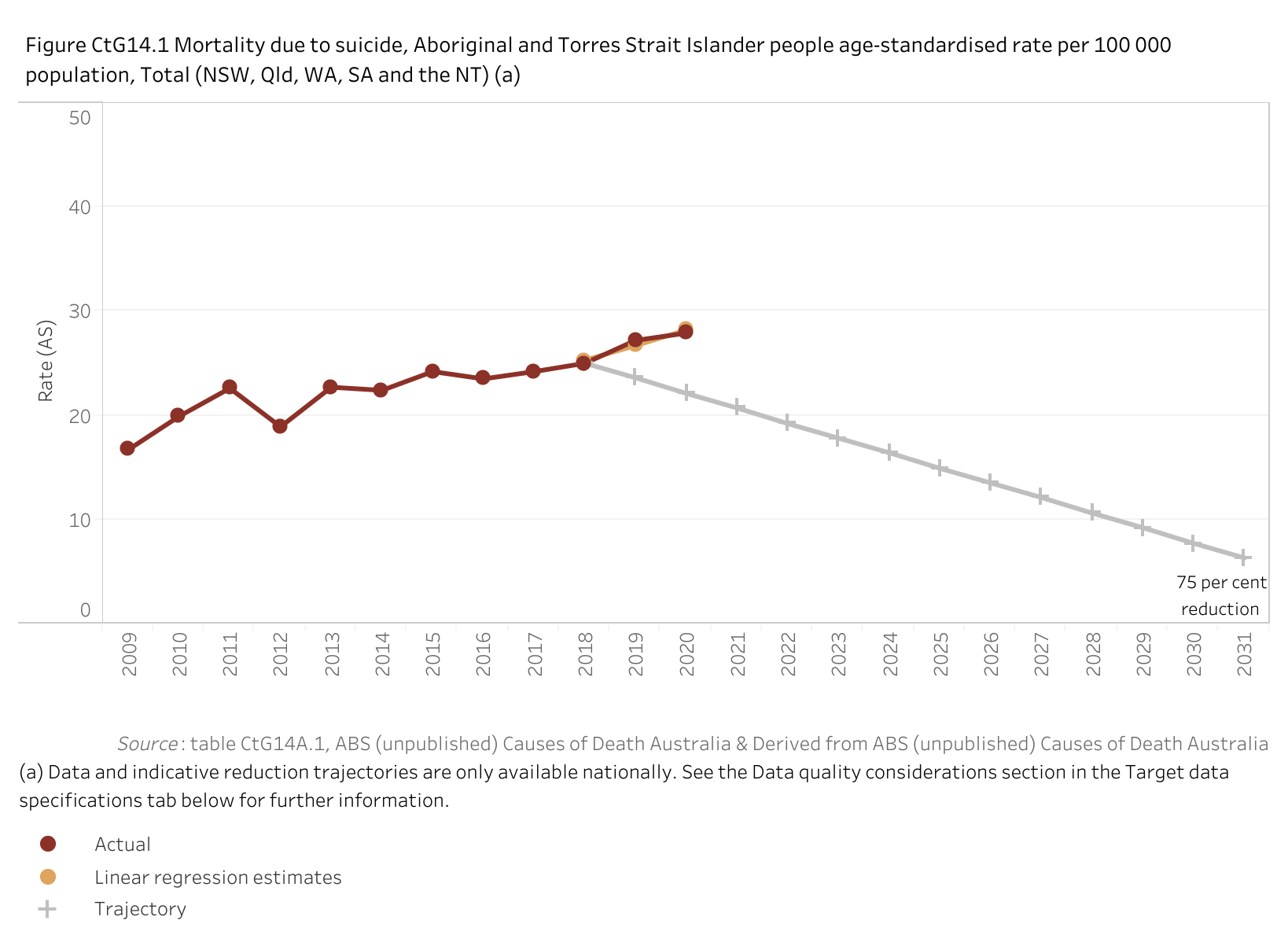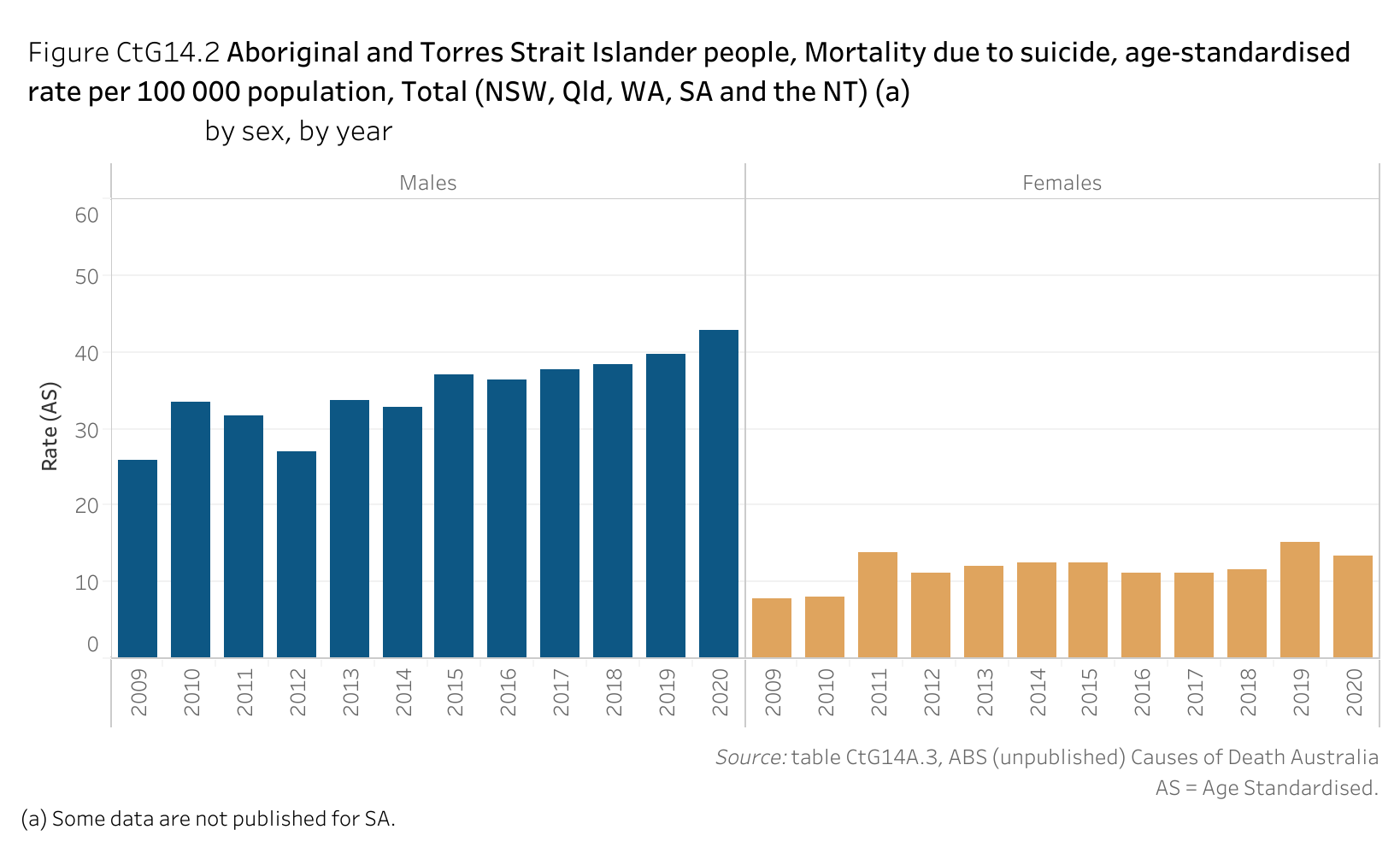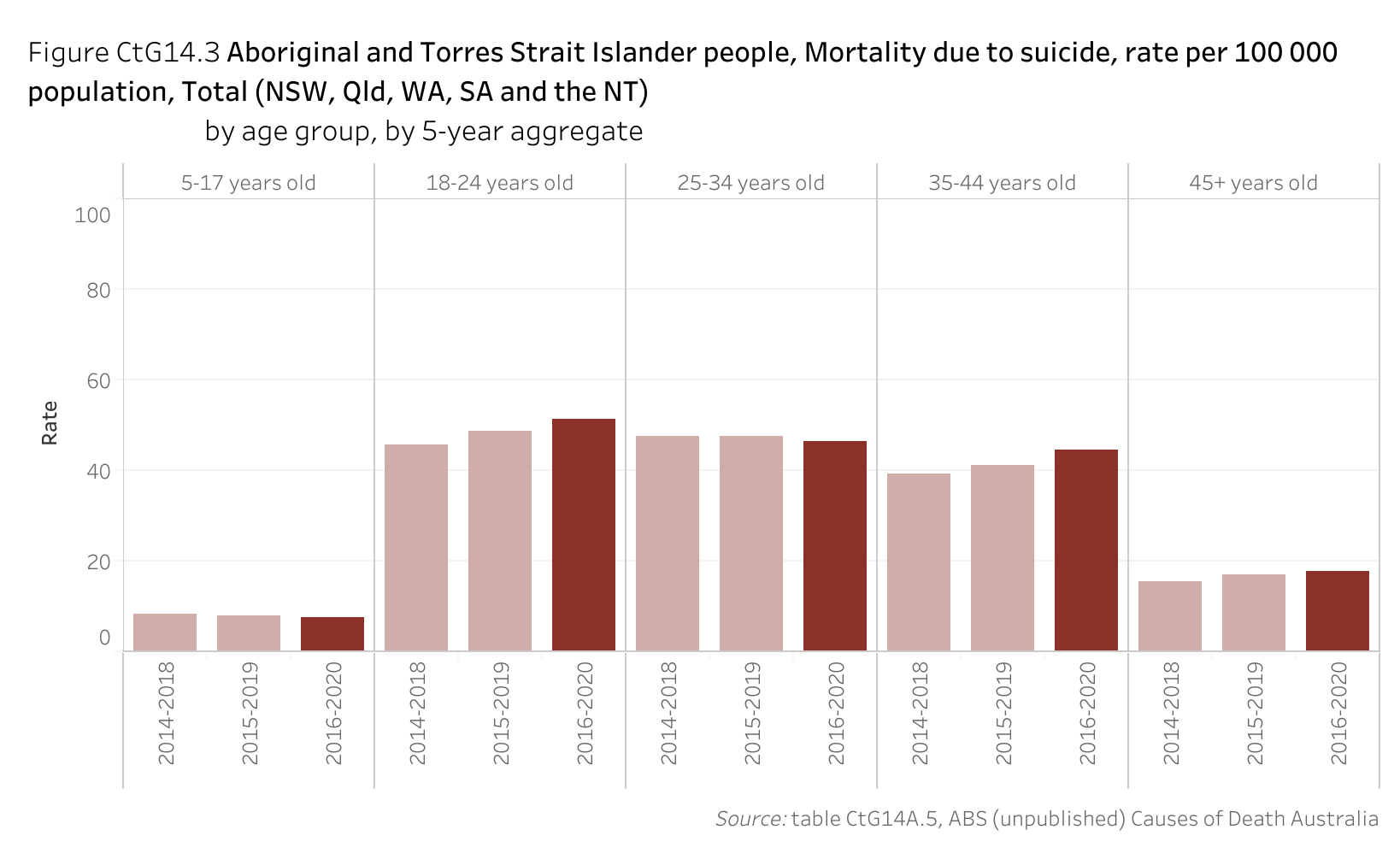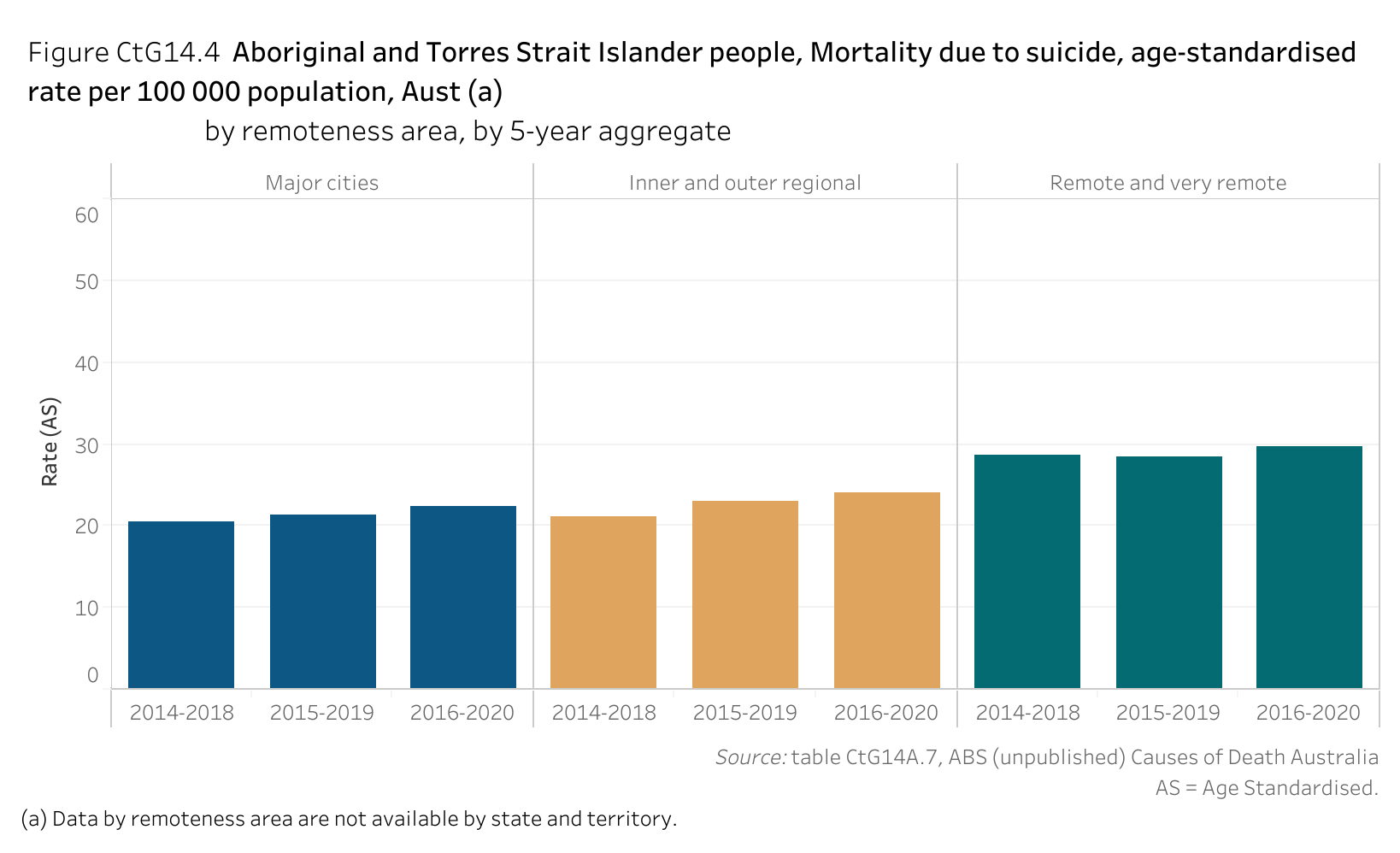Target 14
Significant and sustained reduction in suicide of Aboriginal and Torres Strait Islander people towards zero.
Dashboard snapshot: The data below are the most recent at the time of preparing the July 2022 report. Please go to the dashboard to access the current data.
In 2020, the suicide age-standardised rate for Aboriginal and Torres Strait Islander people was 27.9 per 100 000 people (for NSW, Queensland, WA, SA and the NT combined) (figure CtG14.1).
This is an increase from 25.0 per 100 000 people in 2018 (the baseline year).
There is no specified trajectory or expected timeline for achieving zero suicide. This is because there is no acceptable rate of suicide – today or at any other time. A trajectory of a 75 per cent reduction in the suicide rate is presented here. This trajectory was one of four (20 per cent, 25 per cent, 50 per cent and 75 per cent) developed through National Agreement processes and is presented here as it the most ambitious of the target trajectories.
Nationally, based on progress from the baseline, the target is worsening. However, this assessment should be used with caution as it is based on a limited number of data points. Please see the How to interpret the data page for more information.
Disaggregations
By sex
In 2020, after adjusting for differences in population age structures, the suicide rate for Aboriginal and Torres Strait Islander males for NSW, Queensland, WA, SA and the NT combined was 3.2 times the rate for females (figure CtG14.2).

| 2009 | 2010 | 2011 | 2012 | 2013 | 2014 | 2015 | 2016 | 2017 | 2018 | 2019 | 2020 | |
|---|---|---|---|---|---|---|---|---|---|---|---|---|
| Males | 25.8 | 33.4 | 31.7 | 26.9 | 33.7 | 32.8 | 37.0 | 36.4 | 37.6 | 38.4 | 39.6 | 42.9 |
| Females | 7.8 | 8.1 | 13.8 | 11.2 | 12.1 | 12.4 | 12.4 | 11.2 | 11.2 | 11.7 | 15.2 | 13.4 |
By age group
For the period 2016–2020, for NSW, Queensland, WA, SA and the NT combined, the suicide rates for Aboriginal and Torres Strait Islander people aged 18–24 years, 25–34 years and 35–44 years (51.2, 46.6 and 44.4 per 100 000 population respectively) were more than twice the rates for Aboriginal and Torres Strait Islander people aged 45 years or over and 5–17 years (17.7 and 7.7 per 100 000 population respectively) (figure CtG14.3).

| 2014-2018 | 2015-2019 | 2016-2020 | |
|---|---|---|---|
| 5-17 years old | 8.3 | 8.1 | 7.7 |
| 18-24 years old | 45.8 | 48.5 | 51.2 |
| 25-34 years old | 47.5 | 47.7 | 46.6 |
| 35-44 years old | 39.2 | 41.0 | 44.4 |
| 45+ years old | 15.3 | 16.8 | 17.7 |
By sex, by age group
Data on suicide death rates, by Indigenous status, by sex, by age group are available in table CtG14A.6.
By remoteness area
For the period 2016–2020, the Australian suicide rates for Aboriginal and Torres Strait Islander people were higher in remote and very remote areas (29.6 per 100 000 population) compared to regional areas and major cities (24.0 and 22.3 per 100 000 population respectively) (figure CtG14.4).
Aust

| 2014-2018 | 2015-2019 | 2016-2020 | |
|---|---|---|---|
| Major cities | 20.5 | 21.3 | 22.3 |
| Inner and outer regional | 21.1 | 23.0 | 24.0 |
| Remote and very remote | 28.6 | 28.4 | 29.6 |
By sex, by remoteness area
Data on suicide death rates, by Indigenous status, by sex, by remoteness area are available in table CtG14A.9.
Target data specifications
Outcome: |
Aboriginal and Torres Strait Islander people enjoy high levels of social and emotional wellbeing. |
|---|---|
Target: |
A significant and sustained reduction in suicide of Aboriginal and Torres Strait Islander people towards zero. There is no specified trajectory or expected timeline for achieving zero suicide. A trajectory of a 75 per cent reduction in the suicide rate is presented here as it is the most ambitious of the four target trajectories (20 per cent, 25 per cent, 50 per cent and 75 per cent) developed through National Agreement processes. |
Indicator: |
Suicide death rate of Aboriginal and Torres Strait Islander people. |
Measure: |
The measure is defined as: Numerator — number of Aboriginal and Torres Strait Islander suicide deaths Denominator — number of Aboriginal and Torres Strait Islander people in the population and is presented as an age-standardised rate per 100 000 people. |
Target established: |
National Agreement on Closing the Gap July 2020 |
Latest dashboard update: |
31 March 2022 |
Indicator type: |
Target |
Interpretation of change: |
A low or decreasing rate is desirable. |
Data source(s): |
Name (numerator): Causes of Death, Australia Frequency: Annual (revised data for 2017 and 2018 included in the March 2022 Dashboard update – see Data quality considerations for further information) Name (denominator): Estimates and Projections for Aboriginal and Torres Strait Islander population Frequency: Annual (revised data for 2017, 2018, 2019 and 2020 included in the March 2022 Dashboard update) Documentation (links): https://www.abs.gov.au/statistics/health/causes-death/causes-death-australia/ |
Data provider: |
Provider name: Australian Bureau of Statistics Provider area: Causes of Death |
Baseline year: |
2018 |
Latest reporting period |
2020 |
Target year: |
2031 |
Disaggregations: |
Total (includes NSW, Qld, WA, SA and the NT), Aboriginal and Torres Strait Islander people, single years State and territory (NSW, Qld, WA, SA and the NT only) and total (5 jurisdictions combined), by Indigenous status, 5-year aggregates Total (includes NSW, Qld, WA, SA and the NT), by Indigenous status, single years State and territory (NSW, Qld, WA, SA and the NT) and total (includes NSW, Qld, WA, SA and the NT ), by Indigenous status by sex, 5-year aggregates State and territory (NSW, Qld, WA, SA and the NT) and total (includes NSW, Qld, WA, SA and the NT), by Indigenous status, by age group, 5-year aggregates Suicide death rate, total (includes NSW, Qld, WA, SA and the NT), by age group, by Indigenous status, by sex, 5-year aggregates Suicide death rate, Australia, by remoteness area, by Indigenous status, 5-year aggregates Suicide deaths, state and territory, by remoteness area, 5-year aggregates Suicide death rate, Australia, by remoteness area, by Indigenous status, by sex, 5-year aggregates Suicide deaths, Australia, by remoteness area, by Indigenous status, by sex, 5-year aggregates |
Computation: |
Numerator divided by Denominator multiplied by 100 000 Counting rules Numerator:
Denominator: Estimated population as at 30 June:
Age-standardised rate: Age-standardised rates are calculated using the direct method using 5-year age groups from 0–4 to 75 years and over, with the Australian standard population as at 30 June 2001. For estimates by remoteness area, rates are calculated using 5-year age groups from 0–4 to 65 years and over. See the How to interpret data page for further information. Disaggregations: Causes of death statistics by jurisdiction and remoteness are based on usual residence of the deceased. Deaths of persons usually resident overseas which occur in Australia are included in the state/territory in which their death was registered. Sex relates to biological sexual characteristics. Where the sex of the deceased has not been specified as male or female the death is excluded from the analysis by sex. Remoteness area is classified according to the ABS 2016 Australian Statistical Geography Standard (ASGS) using SA1 as the building block. Data exclude deaths where residence was categorised as ‘migratory’, ‘no known usual residence’, ‘overseas’, or it was not sufficient to identify the geographic area and assign remoteness area. Supporting calculations Suicide death numbers. |
Data quality considerations: |
Reporting of rates is only for those jurisdictions which have adequate levels of Indigenous identification (NSW, Queensland, WA, SA and the NT in line with national reporting guidelines), including the disaggregations. The exception is the data by remoteness which includes all jurisdictions (rather than the 5 jurisdictions in the target indicator) as data on the Estimated Resident Population (ERP) by remoteness are not available by jurisdiction. For disaggregated data, single-year estimates are subject to volatility due to small numbers. Therefore, 5-year aggregates are provided for point-in-time comparisons for jurisdictions and across age groups and remoteness areas. All causes of death data from 2006 onward are subject to a revisions process. Once data for a reference year are 'final', they are no longer revised. Data presented here are final for 2017 and earlier years, at the revised stage for 2018 and preliminary for 2019 and 2020. See the Data quality section of the methodology in the Causes of Death, Australia, 2020 publication available here: Causes of Death, Australia methodology, 2020 | Australian Bureau of Statistics (abs.gov.au) Coronial cases are more likely to be affected by a lag in registration time, especially those which are due to external causes, including suicide. Due to small numbers these lagged coroner-referred registrations can create large yearly variation in some causes of deaths of Aboriginal and Torres Strait Islander persons. Caution should be taken when making year to year analysis. Caution should be taken when interpreting figures relating to intentional self-harm and when conducting time series analysis (due to changes in Indigenous identification and causes of death coding processes over time). See Causes of Death, Australia methodology (www.abs.gov.au/methodologies/causes-death-australia-methodology). Data for Indigenous status are influenced by the quality of Aboriginal and Torres Strait Islander identification of people in the death registration process, which is likely to differ across jurisdictions and over time. In 2020, there were 1195 deaths registered in Australia for whom Indigenous status was not stated, representing 0.7 per cent of all deaths registered. Queensland deaths for 2010 have been adjusted to minimise the impact of a number of late registrations received in that year on mortality indicators. Some age-standardised rates are unreliable due to small numbers of deaths over the reference period. This can result in greater volatility of rates. From 2016, reference year deaths with not stated age have not been prorated. |
Future reporting: |
Additional disaggregations required for future reporting:
|
Supporting indicators
Driver
- Non-fatal hospitalisations for intentional self-harm
- Intentional self-harm mortality rate (suicide)
- Hospitalisations for mental health-related disorders
Contextual information
- Proportion of Aboriginal and Torres Strait Islander people reporting experiencing psychological distress
- Proportion of people reported experiencing one or more barriers accessing health services
- Mental health-related disorders mortality rates
- Proportion who report having experienced racism in the previous 12 months
Material for download
- People enjoy high levels of social and emotional wellbeing data tables (XLSX - 88 Kb)
- People enjoy high levels of social and emotional wellbeing dataset (CSV - 194 Kb)
To assist with interpretation of the data provided (Excel data tables and CSV dataset) please refer to the target data specification (above) and the indicator data specifications (provided in each supporting indicator page – linked above).
